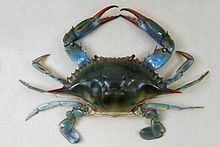Eumalacostraca
| Eumalacostraca | |
|---|---|

| |
| Atlantic blue crab, Callinectes sapidus | |
| Scientific classification | |
| Domain: | Eukaryota |
| Kingdom: | Animalia |
| Phylum: | Arthropoda |
| Class: | Malacostraca |
| Subclass: | Eumalacostraca Grobben, 1892 |
| Superorders | |
Eumalacostraca is a subclass of crustaceans, containing almost all living malacostracans, or about 40,000 described species.[1] The remaining subclasses are the Phyllocarida and possibly the Hoplocarida.[2] Eumalacostracans have 19 segments (5 cephalic, 8 thoracic and 6 abdominal). This arrangement is known as the "caridoid facies", a term coined by William Thomas Calman in 1909. The thoracic limbs are jointed and used for swimming or walking. The common ancestor is thought to have had a carapace, and most living species possess one, but it has been lost in some subgroups.
Caridoid facies
[edit]Calman identified the following features as distinguishing eumalacostracan crustaceans:[3]
"Carapace enveloping the thoracic region; movably stalked eyes; biramous first antenna; scale-like exopod on the second antenna; natatory exopods on the thoracic limbs; elongate, ventrally flexible abdomen; tail fan formed by the lamellar rami of the uropods on either side of the telson."
Classification
[edit]Martin and Davis present the following classification of living eumalacostracans into orders, to which extinct orders have been added, indicated by †.[2]
The group as originally described by Karl Grobben[4] included the Stomatopoda (mantis shrimp), and a number of modern experts and databases (ex. NCBI) continue to use this definition. This article follows Martin and Davis in excluding them; they are placed in their own subclass, Hoplocarida.
Subclass Eumalacostraca Grobben, 1892
- Superorder Syncarida Packard, 1885
- †Order Palaeocaridacea
- Order Bathynellacea Chappuis, 1915
- Order Anaspidacea Calman, 1904 (including Stygocaridacea)
- Superorder Peracarida Calman, 1904
- Order Spelaeogriphacea Gordon, 1957
- Order Thermosbaenacea Monod, 1927
- Order Lophogastrida Sars, 1870
- Order Mysida Haworth, 1825
- Order Mictacea Bowman, Garner, Hessler, Iliffe & Sanders, 1985
- Order Amphipoda Latreille, 1816
- Order Isopoda Latreille, 1817
- Order Tanaidacea Dana, 1849
- Order Cumacea Krøyer, 1846
- Superorder Eucarida Calman, 1904
- Order Euphausiacea Dana, 1852
- Order Decapoda Latreille, 1802
- †Order Angustidontida Gueriau, Charbonnier & Clément, 2014[5]
References
[edit]- ^ Gary C. B. Poore (2002). "Introduction". Crustacea: Malacostraca. Zoological catalogue of Australia. Vol. 19.2A. CSIRO Publishing. pp. 1–7. ISBN 978-0-643-06901-5.
- ^ a b J. W. Martin & G. E. Davis (2001). An Updated Classification of the Recent Crustacea (PDF). Natural History Museum of Los Angeles County. pp. 132 pp. Archived from the original (PDF) on 2013-05-12. Retrieved 2009-12-14.
- ^ Hessler, Robert R. (1983). "A defense of the caridoid facies; wherein the early evolution of the eumalacostraca is discussed". In Schram, Frederick R. (ed.). Crustacean Phylogeny (PDF). Rotterdam: A.A. Balkema. ISBN 90-6191-231-8. Archived from the original (PDF) on 2014-05-14. Retrieved 2014-05-14.
- ^ C. Grobben (1892). "Zur Kenntnis des Stammbaumes und des Systems der Crustaceen". Sitzungsberichte der Kaiserlichen Akademie der Wissenschaften, Vienna. Mathematisch-naturwissenschaftliche Classe. 101: 237–274.
- ^ Gueriau, Pierre; Charbonnier, Sylvain; Clément, Gaël (2014-09-01). "Angustidontid crustaceans from the Late Devonian of Strud (Namur Province, Belgium): Insights into the origin of Decapoda". Neues Jahrbuch für Geologie und Paläontologie - Abhandlungen. 273. doi:10.1127/0077-7749/2014/0434.
